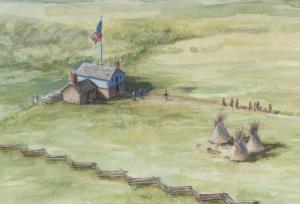 "The Indian . . . came into reservation life reluctantly. . . . He was practically a prisoner, to be fed and treated as such; and what resources were left him must be controlled by the Indian Bureau through its resident agent."
"The Indian . . . came into reservation life reluctantly. . . . He was practically a prisoner, to be fed and treated as such; and what resources were left him must be controlled by the Indian Bureau through its resident agent."
Ohiyesa (Charles A. Eastman), The Indian Today, 1915
Indian agencies were created as part of the U.S. government's efforts to control trade and settle disputes between the United States and American Indian nations. Government-appointed Indian agents oversaw the agencies, and reported any violations to the U.S. War Department.
In Minnesota, agents at the St. Peter's Agency encouraged Dakota people to give up hunting as a primary method of subsistence, to educate their children according to European-American standards, to practice Christianity rather than their traditional religion, and to adopt European-American agricultural methods.
The agents also encouraged changes to Dakota gender roles. Traditionally, Dakota women and children had worked fields and gardens, and the agents wanted men to give up hunting and expand their approach to farming. Agents as well as missionaries encouraged the Dakota to adopt farming on a larger scale so it could serve as the main form of subsistence for their communities, and to utilize European-American cultivation methods, such as the use of plows drawn by draft animals.





